Head, Neck, and Trunk Muscles
Objective 10.12
10.12.1 Give the origin, insertion, and action of the major muscles of the head, neck, and trunk.
10.12.2 Identify these muscles on a picture or image.
Head, Neck & Trunk
Masseter
The masseter is a major muscle of mastication (chewing).
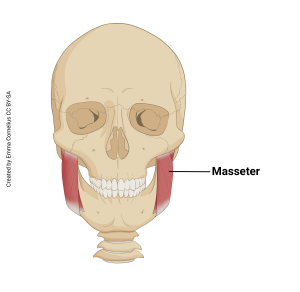

Sternocleidomastoid (SCM)
The sternocleidomastoid is a lot of people’s favorite muscle because it is fun to say. You will often see it abbreviated as SCM. Sterno- refers to the sternum. Cleido- refers to the clavicle. Mastoid refers to the mastoid process of the temporal bone.
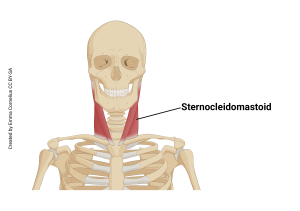

Trapezius
The trapezius is named for its shape. When looking at both the right and left trapezius muscles together, they form a trapezoid, hence their name. It is common for people to get muscle pain in this muscle, especially if they are stressed. The trapezius has many functions, but we will not explore too many of them here.
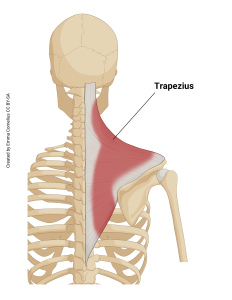

Breathing Muscles: Diaphragm, Internal & External Intercostals
The diaphragm, internal intercostals, and external intercostals play a role in breathing. You will remember from Unit 1 that the diaphragm separates the thoracic cavity from the abdominal cavity. The diaphragm is active for inhalation and relaxes for exhalation. The intercostals are muscles that run between the ribs. They play a role in either exhalation or inhalation as noted below by either elevating or depressing the ribs. We will study these muscles more in the respiratory system (Unit 17).
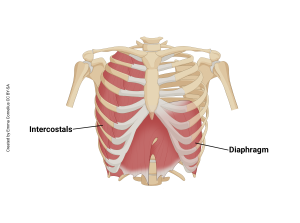
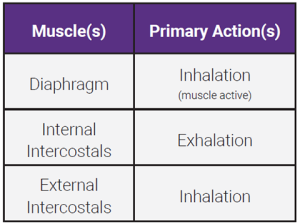
Abdominals
The abdominal muscles perform a variety of functions, but for this unit, we just want you to be familiar with their names and basic functions.
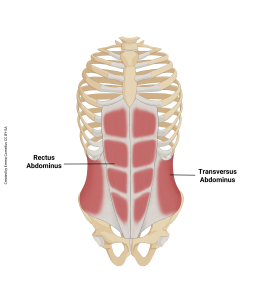
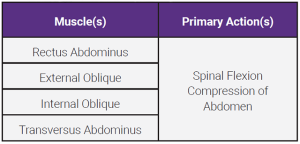
Erector Spinae
The erector spinae are a grouping of three muscles: spinalis, longissimus, iliocostalis. You do not need to know them individually, just collectively. Together, they are spinal extensors. They play a major role in maintaining upright posture.
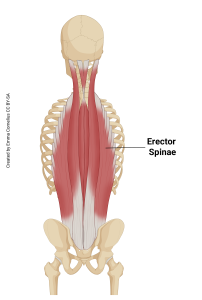

Media Attributions
- U10-091 masseter © Cornelius, Emma is licensed under a CC BY-SA (Attribution ShareAlike) license
- U10-092 masseter origin and insertion table © Bizzell, Lizz is licensed under a CC BY-SA (Attribution ShareAlike) license
- U10-093 sternocleidomastoid © Cornelius, Emma is licensed under a CC BY-SA (Attribution ShareAlike) license
- U10-094 sternocleidomastoid origin and insertion table © Bizzell, Lizz is licensed under a CC BY-SA (Attribution ShareAlike) license
- U10-095 trapezius © Cornelius, Emma is licensed under a CC BY-SA (Attribution ShareAlike) license
- U10-096 trapezius origin and insertion table © Bizzell, Lizz is licensed under a CC BY-SA (Attribution ShareAlike) license
- U10-097 intercostals and diaphragm © Cornelius, Emma is licensed under a CC BY-SA (Attribution ShareAlike) license
- U10-098 intercostals origin and insertion table © Bizzell, Lizz is licensed under a CC BY-SA (Attribution ShareAlike) license
- U10-099 abdominals © Cornelius, Emma is licensed under a CC BY-SA (Attribution ShareAlike) license
- U10-100 abdominals origin and insertion table © Bizzell, Lizz is licensed under a CC BY-SA (Attribution ShareAlike) license
- U10-101 erector spinae © Cornelius, Emma is licensed under a CC BY-SA (Attribution ShareAlike) license
- U10-102 erector spinae origin and insertion table © Bizzell, Lizz is licensed under a CC BY-SA (Attribution ShareAlike) license

